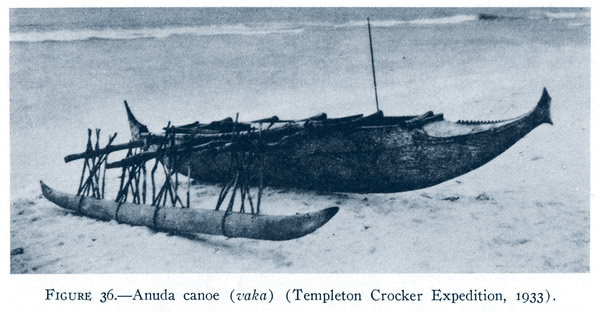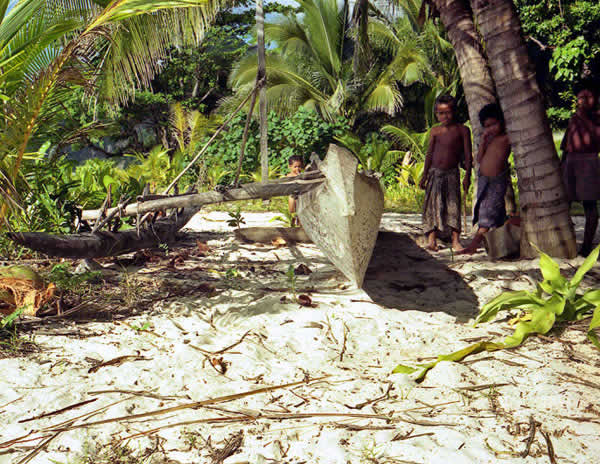The Tikopian Canoes

The people of Tikopia and her sister island Anuta have built canoes of a very distinctive design for hundreds of years. This canoe design is probably the only Polynesian ocean going sailing hull design to have survived the total destruction of the Polynesian ocean voyaging culture since the arrival of Western Sailors and later missionaries in the Pacific.
Due to Tikopia’s isolation and position surrounded by 100s of miles of open ocean her canoes always had to be seaworthy, even the small ones. In 1828/9 Admiral Paris, an eminent and very knowledgeable French seaman, meticulously recorded some of the few surviving Polynesian canoe designs he found still in use in the Pacific. One of these was the voyaging double canoe of the Tuamotu islands, one of the few remaining places in the Pacific where at that time the population still had a tradition of making longer ocean voyages. A beautiful lines drawing and model of this type of boat is kept in the Louvre museum in Paris. The other canoe hull he recorded in writing was the Tikopian canoe shape (Haddon & Hornell). His description of this canoe closely matches the still existing Tikopian canoes built between approx. 1880 and the 1970s.
As Tikopia had hardly been touched by Western man in the 1820s, it can be true to say their canoe design was also untouched by Western influence and is therefore a unique example of a seagoing canoe hull design that has its origins maybe as far back as 1000 years or more.
The Tikopians and Anutans kept their canoe building tradition well into the 20th century, but by 1996, when we visited the island on our 63’ double canoe ‘Spirit of Gaia’ no-one was building canoes on Tikopia. Some of the canoes they were using were built on Vanikoro, where Tikopian canoe builders still practiced.
The canoe building tradition has lasted longer on Anuta. Richard Feinberg, Professor of Anthropology at Kent State University, made a study of canoe building and navigation on Anuta in 1972/3, which he describes in detail in his book ‘Polynesian Seafaring and Navigation - Ocean Travel in Anutan Culture and Society ’, canoes are still being built on Anuta, but many canoes produced these days are small and lack some of the distinctive Tikopian hull features.
When Tikopia officially adopted the Christian religion, the island owned a 9m ‘Sacred Canoe ~ Vaka Tapu’. At this point there was debate that this canoe should be destroyed as it represented the old religion, but fortunately the (great?) Grandfather of Chief Taumako had the clever thought of donating the Sacred Canoe to Bishop Woods of Auckland. This means that now this beautiful canoe still exists and is displayed in the Auckland Imperial Museum in perfect condition since its donation in 1916.
Extract from the 'Lonely Planet Guide’' about Tikopia:
Inter-lsland Voyaging
In the past, there was frequent trade between Tikopia and the Banks Islands. The ariki kafika has an ancestral claim to a small islet there, called Ravenga. It's just off Vanua Lava, 204 km to Tikopia's south-west. In 1891, a missionary called Coddrington reported that as many as 11 large Tikopian trading canoes used to visit Vanua Lava at a time. However, there have been few successful Tikopian voyages to the Banks since WW II, and none since Independence.
Anuta is Tikopia's closest neighbour, 150 km distant.The two islands are close enough for the people of both to regard each other as wantoks, each family having a parallel family on the other island to which they belong. Regular canoe visits used to be made to Anuta, with Tikopian canoeists sometimes diverting to desolate Fatutaka for sea-birds' eggs. Another classic trade route was to Vanikolo, where Tikopian mats were traded for Vanikolan arrows. On very rare occasions, voyagers went as far as Rennell, over 1000 km away.
The omnipresent ocean permeates every aspect of the islanders' lives. Wild seas and shipwreck seldom deter them. Such a death is called sweet burial. Tikopians do not say left or right - only inland or seawards.
Tikopia in the 20th Century
Since Raymond Firth's anthropological studies in Tikopia in 1928/9 the island has slowly been absorbing influences of the 20th century and the rest of the world. At the begining of the 20th Century, the islanders accepted the Christian religon, but when this decision was made, the chiefs decided that they would only welcome one sect of the Christian church. Their choice was the Anglican church, probably a very sensible choice as it hasn't been trying to dominate the island and wipe out all it's traditions. We have heard that on the side of the island that receives least visitors (the East side furthest from anchorage) there are still older Polynesian believes and cultural traditions practiced.





